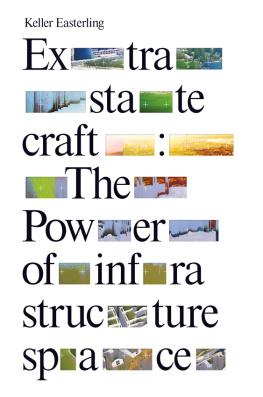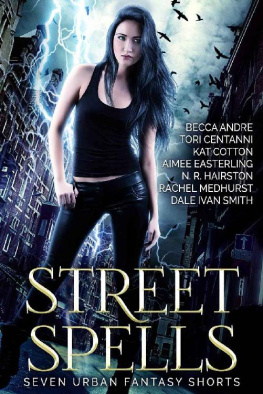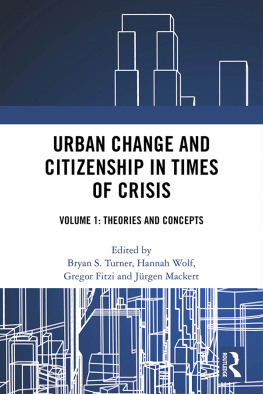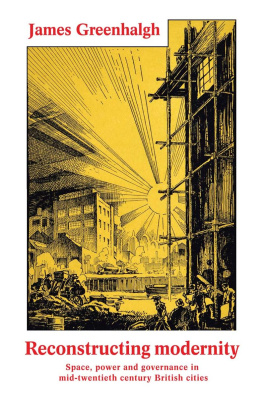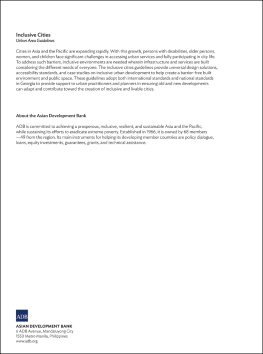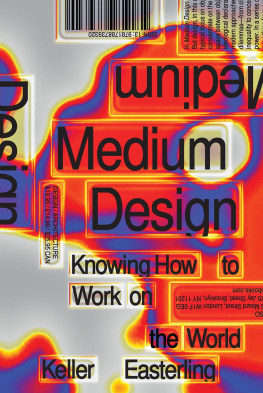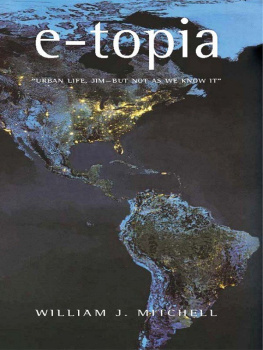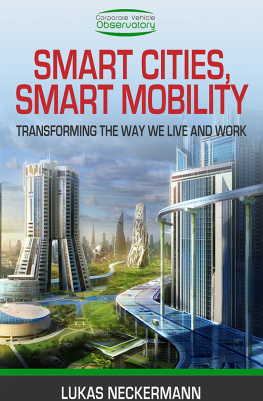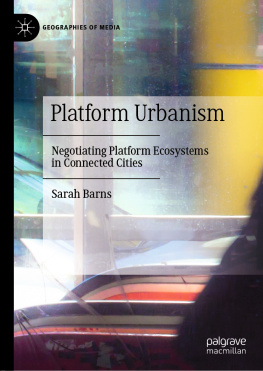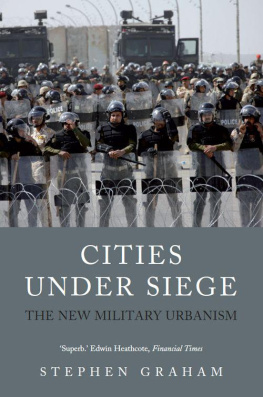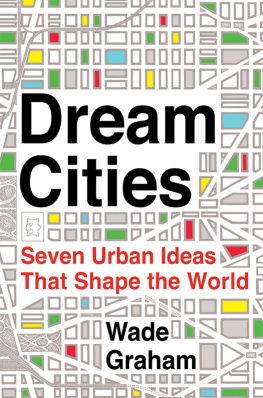Every effort has been made to trace copyright holders and to obtain permission for
the use of copyright material for the illustrations herein. The publisher apologizes
for any errors or omissions and would be grateful if notified of any corrections that
should be incorporated in future reprints or editions of this book.
Includes bibliographical references and index.
ISBN 978-1-78168-587-7 (hardback)ISBN 978-1-78168-588-4 (e)
1. Space (Architecture)Social aspects. 2. Power (Social sciences) I. Title.
NA2765.E23 2014
720.103dc23
2014012812
Verso, and especially editor Leo Hollis, deserve sincere thanks. The care and good cheer with which he edited the text for a general audience prompted not only clarifications but also discoveries for which the author could not be more grateful. Thanks also go to Mark Martin, Tim Clark, and designers Andy Pressman and Michael Oswell at Verso. Like a parallel text, the notes hopefully account for debts to ongoing scholarly discourses that a general audience may not wish to parse.
Yale Universitys Gustav Ranis Prize, the Graham Foundation for Advanced Studies in the Fine Arts, the Cornell Society for the Humanities, and the Jan van Eyck Academie provided funding for portions of the research and production of this book.
Colleagues and friends read drafts of the manuscript in progress: Ljiljana Blagojevic, Roger Conover, Stephen Graham, Michelle Komie, Nancy Levinson, Mitch McEwen, Brian McGrath, Susanna Newbury, Dara Orenstein, Vyjayanthi Rao, Andreas Ruby, and Ilka Ruby.
Several projects or collective research efforts contributed to segments of the book.
Research on the free zone was assembled for the 2007 Architecture Biennale in Rotterdam (Head of Programme Christine de Baan). Material for the chapter titled Zone was first published as a chapter in the book Visionary Power (2007).
A number of people assisted me in my research in Kenya including Mwangi Gathinji, Brian Herlihy, Professor Kigara Kamweru, John Mugabe, Pamela Odero, Simon Olawo, Dr. Bitange Ndemo, John Sihra, Steve Song, and Kai Wolff.
Material from the chapter titled Broadband was first published as Cable in New Geographies (2009). The research for this chapter was prepared to supplement the work of a research unit at the Jan van Eyck Academie that included Santiago del Hierro, Gary Leggett, Dubravka Sekuli, Vesna Tomse, and Nadar Vossoughian. A website set up to present some of the research was designed by Tomas Celizna, with video by Min Oh and Celizna.
The final segment of the book, on alternative activist techniques, was first developed in 2008 for a master class and public lecture at the Berlage Institute at the invitation of Vedran Mimica and Saloman Frausto. Material for the chapter titled Extrastatecraft was first published in Hunch 12: Bureaucracy (2009). A collaborative exhibition at Storefront for Art and Architecture in 2008 titled Some True Stories experimented with some of these activist techniques. The team of collaborators included Gaby Brainard, Ashima Chitre, Neil Donnelly, Mwangi Gathinji, Santiago del Hierro, Mustapha Jundi, Rustam Mehta, Thom Moran, Jacob Reidel, and Carol Ruiz.
The book has benefited enormously from the intelligence of editors who have published portions of it. I am grateful to Justin McGuirk for publishing an ebook essay The Action Is the Form (Strelka Press, 2012) and to Nancy Levinson for publishing Zone: The Spatial Softwares of Extrastatecraft in Design Observer (2012)two previews of the present book. Joseph Grima, first as the director of Storefront for Art and Architecture and then as the editor of Domus, has supported the work, as have Mark Wigley and Jeffrey Inaba for C-Lab and Volume. The journal Perspecta also published related research, and thanks are due to Dean Robert A.M. Stern and editors Kanu Agrawal, Gaby Brainard, Melanie Domino, Iben Falconer, Rustam Mehta, Thom Moran, Matthew Roman, Tal Schori, and Brad Walters. Other editors to whom I am indebted include Marc Anglil, Shumon Basar, Helen Castle, Dana Cuff, Cynthia Davidson, Peggy Deamer, Alexander Eisenschmidt, Daniela Fabricious, Homa Fajardi, Rania Gosn, Deborah Hauptmann, Aaron Levy, Sina Najafi, Warren Neidich, Amanda Reeser, Mark Shepard, Ashley Schafer, Lola Sheppard, Roger Sherman, Andreas and Ilke Ruby, Neyran Turan, Markus Miessen, Maya Przybylski, Daniel van der Velden, Marina Vishmidt, Srdjan Jovanovich Weiss, and Mason White.
Friends who provided support or reflection on the work include Arjun Appadurai, Julieta Aranda, Jonathan Bach, Shumon Basar, Chloe Bass, Ursula Beimann, Markley Boyer, Lindsay Bremner, Jordan Carver, Benedict Clouette, Beatriz Colomina, Jordan Crandall, Teddy Cruz, Shiela and Peter DeBretteville, Santiago del Hierro, Tina di Carlo, Elizabeth Diller, Edward Dimendberg, Kodwo Eshun, Homa Fajardi, Renate Ferro, Annette Fierro, Ray Gastil, Jordan Geiger, Eva Franc-Gilibert, Sara Goldsmith, Claudia Gould, Paul Gunther, Dolores Hayden, Molly Hickock, Nikolaus Hirsch, Jeffrey Inaba, Susan Jonas, Branden Joseph, Tom Keenan, Laura Kurgan, Jesse LeCavalier, Siddhartha Lokanandi, Marcell Mars, Reinhold Martin, Ana Miljacki, Mohsen Mostafavi, Tim Murray, John Palmesino, Satya Pemmaraju, Alan Plattus, Irit Rogoff, Ann-Sofi Rnnskog, Jenny Sabin, Joel Sanders, Fred Scharmen, Felicity D. Scott, Dubravka Sekulic, Michael Serino, Brett Steele, Daniel van der Velden, Misa Miodrag Vujoevi, Mark Wasiuta, Eyal Weizman, Ines Weizman, Mark Wigley, Darien Williams, Brian Kuan Wood, and Gwendolyn Wright.
Several studentsAnn-Marie Armstrong, A.J. Artemel, E. Sean Bailey, Swarnabh Ghosh, Brandon Hall, Gary Leggett, Rustam Mehta, Craig Rosman, and Ian Starlingprovided research assistance. And too many students to name, in both seminars and lecture courses, contributed their wisdom and curiosity.
The book is dedicated to the memory of Detlef Mertins.
Microwaves bounce between billions of cell phones. Computers synchronize. Shipping containers stack, lock, and calibrate the global transportation and production of goods. Credit cards, all sized 0.76mm, slip through the slots in cash machines anywhere in the world. All of these ubiquitous and seemingly innocuous features of our world are evidence of global infrastructure.
The word infrastructure typically conjures associations with physical networks for transportation, communication, or utilities. Infrastructure is considered to be a hidden substratethe binding medium or current between objects of positive consequence, shape, and law. Yet today, more than grids of pipes and wires, infrastructure includes pools of microwaves beaming from satellites and populations of atomized electronic devices that we hold in our hands. The shared standards and ideas that control everything from technical objects to management styles also constitute an infrastructure. Far from hidden, infrastructure is now the overt point of contact and access between us allthe rules governing the space of everyday life.

